Microsoft RM-595 CDMA cellular phone w/BT User Manual RM595 EN RUIM FCC
Microsoft Mobile Oy CDMA cellular phone w/BT RM595 EN RUIM FCC
Manual
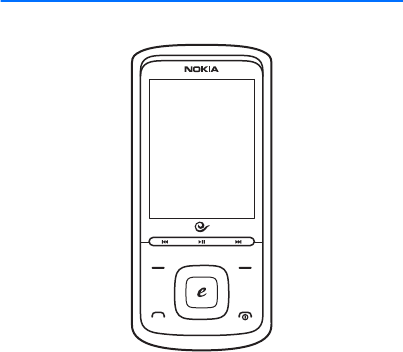
RM-595 User Guide
Draft

© 2009 Nokia. All rights reserved.
Nokia, Nokia Connecting People, and Navi are trademarks or registered
trademarks of Nokia Corporation. Nokia tune is a sound mark of Nokia
Corporation. Other product and company names mentioned herein may be
trademarks or tradenames of their respective owners.
Reproduction, transfer, distribution, or storage of part or all of the
contents in this document in any form without the prior written
permission of Nokia is prohibited.
Includes RSA BSAFE cryptographic or security protocol software
from RSA Security.
Nokia operates a policy of ongoing development. Nokia reserves the right
to make changes and improvements to any of the products described in
this document without prior notice.
TO THE MAXIMUM EXTENT PERMITTED BY APPLICABLE LAW, UNDER NO
CIRCUMSTANCES SHALL NOKIA OR ANY OF ITS LICENSORS BE
RESPONSIBLE FOR ANY LOSS OF DATA OR INCOME OR ANY SPECIAL,
INCIDENTAL, CONSEQUENTIAL OR INDIRECT DAMAGES HOWSOEVER
CAUSED.
THE CONTENTS OF THIS DOCUMENT ARE PROVIDED "AS IS" EXCEPT AS
REQUIRED BY APPLICABLE LAW, NO WARRANTIES OF ANY KIND, EITHER
EXPRESS OR IMPLIED, INCLUDING, BUT NOT LIMITED TO, THE IMPLIED
WARRANTIES OF MERCHANTABILITY AND FITNESS FOR A PARTICULAR
PURPOSE, ARE MADE IN RELATION TO THE ACCURACY, RELIABILITY OR
CONTENTS OF THIS DOCUMENT. NOKIA RESERVES THE RIGHT TO REVISE
THIS DOCUMENT OR WITHDRAW IT AT ANY TIME WITHOUT PRIOR NOTICE.
Reverse engineering of any software in the Nokia device is prohibited to
the extent permitted by applicable law. Insofar as this user guide contains
any limitations on Nokia’s representations warranties, damages and
Draft
liabilities, such limitations shall likewise limit any representations,
warranties, damages and liabilities of Nokia’s licensors.
The availability of particular products and applications for these products
may vary by region. Please check with your Nokia dealer for details, and
availability of language options.
Export controls
This device may contain commodities, technology, or software subject to
export laws and regulations from the US and other countries. Diversion
contrary to law is prohibited.
The third-party applications provided with your device may have been
created and may be owned by persons or entities not affiliated with or
related to Nokia. Nokia does not own the copyright or intellectual property
rights to the third-party applications. As such, Nokia does not take any
responsibility for end-user support, functionality of the applications, or the
information in the applications or these materials. Nokia does not provide
any warranty for the third-party applications.
BY USING THE APPLICATIONS YOU ACKNOWLEDGE THAT THE
APPLICATIONS ARE PROVIDED AS IS WITHOUT WARRANTY OF ANY KIND,
EXPRESS OR IMPLIED, TO THE MAXIMUM EXTENT PERMITTED BY
APPLICABLE LAW. YOU FURTHER ACKNOWLEDGE THAT NEITHER NOKIA
NOR ITS AFFILIATES MAKE ANY REPRESENTATIONS OR WARRANTIES,
EXPRESS OR IMPLIED, INCLUDING BUT NOT LIMITED TO WARRANTIES OF
TITLE, MERCHANTABILITY OR FITNESS FOR A PARTICULAR PURPOSE, OR
THAT THE APPLICATIONS WILL NOT INFRINGE ANY THIRD-PARTY PATENTS,
COPYRIGHTS, TRADEMARKS, OR OTHER RIGHTS.
FCC NOTICE
Your device may cause TV or radio interference (for example, when using a
telephone in close proximity to receiving equipment). The FCC can require
Draft
you to stop using your telephone if such interference cannot be eliminated.
If you require assistance, contact your local service facility. This device
complies with part 15 of the FCC rules. Operation is subject to the
following two conditions: (1) This device may not cause harmful
interference, and (2) this device must accept any interference received,
including interference that may cause undesired operation. Any changes or
modifications not expressly approved by Nokia could void the user’s
authority to operate this equipment.
xxxxxxx/Issue 1
Draft
Contents
SAFETY........................................................................................ 7
1. Get started......................................................................... 11
Install the UIM card and battery........................................................................ 11
Insert and remove the microSD card................................................................. 13
Charge the battery.................................................................................................. 15
Switch your device on or off ............................................................................... 16
Normal operating position ................................................................................... 16
Access codes............................................................................................................. 17
Nokia support on the web.................................................................................... 18
2. Your device ........................................................................ 19
Keys and parts (front) ............................................................................................ 19
Keys and parts (back)............................................................................................. 20
Standby mode and shortcuts............................................................................... 21
Active Standby......................................................................................................... 22
Keyguard.................................................................................................................... 23
3. Call functions ..................................................................... 24
Make a call................................................................................................................ 24
Answer or reject a call........................................................................................... 24
Conference call........................................................................................................ 25
Loudspeaker.............................................................................................................. 25
Voice dialling............................................................................................................ 26
4. Write text .......................................................................... 28
Switch between input methods.......................................................................... 28
Pinyin input method............................................................................................... 29
Stroke input method .............................................................................................. 29
Phrase input.............................................................................................................. 31
Set predictive English input on and off............................................................ 33
Draft
Traditional English input....................................................................................... 33
Predictive English input ........................................................................................ 33
Tips for writing text................................................................................................ 34
5. Voice commands................................................................. 36
Activate and use voice commands..................................................................... 36
Voice commands settings ..................................................................................... 37
6. Menu functions................................................................. 38
Messaging ................................................................................................................. 38
Contacts..................................................................................................................... 47
Log............................................................................................................................... 49
esurfing...................................................................................................................... 50
Web............................................................................................................................. 50
Best Tone................................................................................................................... 51
Customer Service .................................................................................................... 51
Settings...................................................................................................................... 51
Gallery ........................................................................................................................ 64
Media.......................................................................................................................... 65
Organiser ................................................................................................................... 71
Extras.......................................................................................................................... 75
7. Accessories.......................................................................... 76
8. Battery and charger information ..................................... 77
Battery information................................................................................................ 80
Nokia battery authentication guidelines.......................................................... 81
Care and maintenance............................................................ 84
Additional safety information ............................................... 87
Index ........................................................................................ 95
Draft

7
SAFETY
Read these simple guidelines. Not following them may be
dangerous or illegal. Read the complete user guide for further
information.
SWITCH ON SAFELY
Do not switch the device on when wireless phone use
is prohibited or when it may cause interference or
danger.
ROAD SAFETY COMES FIRST
Obey all local laws. Always keep your hands free to
operate the vehicle while driving. Your first
consideration while driving should be road safety.
INTERFERENCE
All wireless devices may be susceptible to
interference, which could affect performance.
SWITCH OFF IN RESTRICTED AREAS
Follow any restrictions. Switch the device off in
aircraft, near medical equipment, fuel, chemicals, or
blasting areas.
QUALIFIED SERVICE
Only qualified personnel may install or repair this
product.
Draft

8
ACCESSORIES AND BATTERIES
Use only approved accessories and batteries. Do not
connect incompatible products.
WATER-RESISTANCE
Your device is not water-resistant. Keep it dry.
■About your device
The wireless device (RM-595) described in this guide is approved
for use on the CDMA 800 MHz network. Contact your service
provider for more information about networks.
When using the features in this device, obey all laws and respect
local customs, privacy and legitimate rights of others, including
copyrights.
Copyright protection may prevent some images, music, and other
content from being copied, modified or transferred.
Your device may have preinstalled bookmarks and links for third-
party internet sites. You may also access other third-party sites
through your device. Third-party sites are not affiliated with
Nokia, and Nokia does not endorse or assume liability for them. If
you choose to access such sites, you should take precautions for
security or content.
Draft

9
Warning: To use any features in this device, other than
the alarm clock, the device must be switched on. Do not
switch the device on when wireless device use may
cause interference or danger.
Remember to make back-up copies or keep a written record of all
important information stored in your device.
When connecting to any other device, read its user guide for
detailed safety instructions. Do not connect incompatible
products.
■Network services
To use the device you must have service from a wireless service
provider. Many of the features require special network features.
These features are not available on all networks; other networks
may require that you make specific arrangements with your
service provider before you can use the network services. Using
network services involves transmission of data. Check with your
service provider for details about fees in your home network and
when roaming in other networks. Your service provider can give
you instructions and explain what charges will apply. Some
networks may have limitations that affect how you can use
network services. For instance, some networks may not support
all language-dependent characters and services.
Draft
10
Your service provider may have requested that certain features be
disabled or not activated in your device. If so, these features will
not appear on your device menu. Your device may also have a
special configuration such as changes in menu names, menu
order, and icons. Contact your service provider for more
information.
This device supports WAP 2.0 protocols (HTTP and SSL) that run
on TCP/IP protocols. Some features of this device, such as sending
e-mail, browsing websites, or downloading files require network
support for these technologies.
Draft
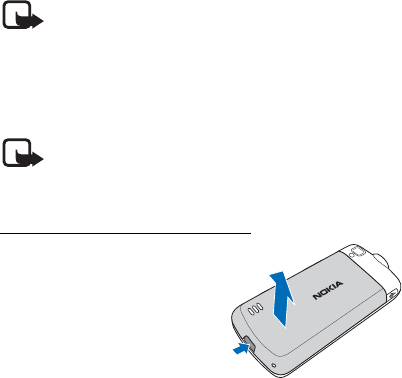
11
1. Get started
■Install the UIM card and battery
Note: Always switch the phone off and
disconnect the charger and any other device
before removing the cover. Avoid touching
electronic components while changing the cover.
Always store and use the device with the cover
attached.
Note: Always switch the device off and
disconnect the charger before removing the
battery.
Remove the back cover and battery
1. To remove the back cover,
with the back of the device
facing you, press the
release button, and lift up
the back cover.
Draft
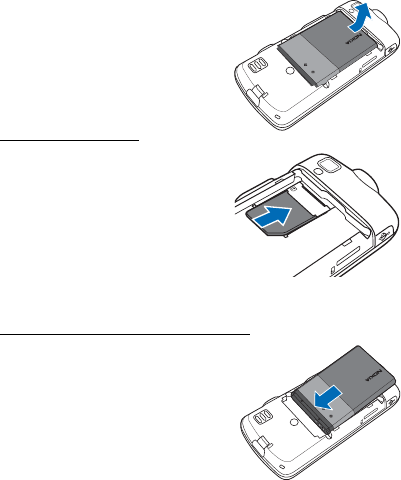
12
2. To remove the battery,
insert your finger into the
finger grip, and lift the
battery from its
compartment.
Insert the UIM card
Ensure that the contact area on
the UIM card is facing
downwards and the bevelled
corner on the card is facing
outwards from the top of the
device, and insert the UIM card
into the card slot.
Replace the battery and back cover
1. To insert the battery,
position the battery by
aligning the contacts with
those on the device, and
press down on the other end
of the battery to snap the
battery into place.
BL-4C
BL-4C
Draft
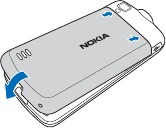
13
2. To replace the back cover,
insert the tabs at the top of
the cover into the slots in
the device, and press down
on the other end of the back
cover.
■Insert and remove the microSD card
Use only compatible microSD cards approved by Nokia for
use with this device. Nokia uses approved industry
standards for memory cards, but some brands may not be
fully compatible with this device. Incompatible cards may
damage the card and the device and corrupt data stored
on the card.
Draft
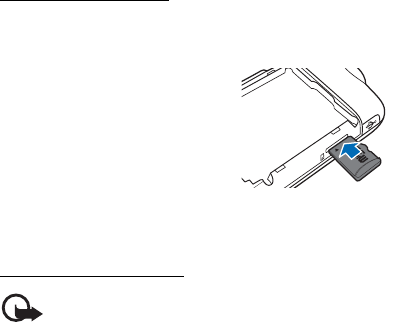
14
Insert the microSD card
1. Remove the back cover. See step 1 in "Remove the back
cover and battery", p. 11.
2. Ensure that the contact area
on the microSD card is facing
downwards, and insert the
microSD card into the card
slot until it clicks into place.
3. Replace the cover. See step 2
in "Replace the battery and
back cover", p. 12.
Remove the microSD card
Important: Do not remove the memory card in
the middle of an operation when the card is being
accessed. Removing the card in the middle of an
operation may damage the memory card as well
as the device, and data stored on the card may be
corrupted.
1. Remove the back cover. See step 1 in "Remove the back
cover and battery", p. 11.
Draft
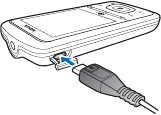
15
2. Press the microSD card slightly into the card slot,
release to eject the card, and remove it from the slot.
3. Replace the cover. See step 2 in "Replace the battery
and back cover", p. 12.
■Charge the battery
Your battery has been partially charged at the factory. If
the device indicates a low charge, do the following:
1. Connect the charger to a wall
socket.
2. Connect the charger to the
device.
3. When the device indicates a
full charge, disconnect the
charger from the device, then
from the wall outlet.
You do not need to charge the battery for a specific length
of time, and you can use the device while it is charging. If
the battery is completely discharged, it may take several
minutes before the charging indicator appears on the
display or before any calls can be made.
Draft
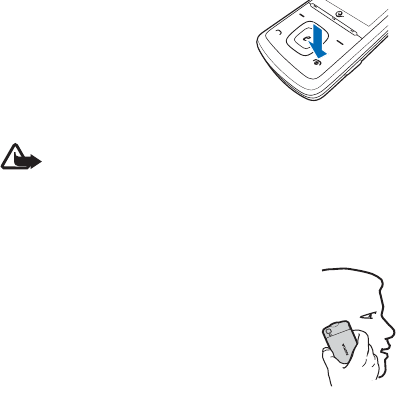
16
■Switch your device on or off
Press and hold the power key on
the keypad for at least three
seconds.
Warning: Do not switch the device on when
wireless phone use is prohibited or when it may
cause interference or danger.
■Normal operating position
Your device has an internal antenna. Use
the device only in its normal operating
position.
Draft
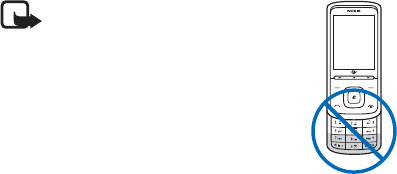
17
Note: Your device may have
internal and external antennas. As
with any radio transmitting
device, avoid touching the
antenna area unnecessarily while
the antenna is transmitting or
receiving. Contact with such an
antenna affects the
communication quality and may
cause the device to operate at a higher power
level than otherwise needed and may reduce the
battery life.
■Access codes
When the device or keypad is locked, calls may be possible
to the official emergency number programmed into your
device. Making an emergency call in the offline profile or
when the device is locked requires that the device
recognise the number to be an official emergency number.
It is advisable to change the profile or unlock the device by
entering the lock code before you make the emergency
call.
Draft

18
To activate the device when it is locked, enter the lock
code. The default lock code is 1234.
To define the security settings for your device, select
Menu > Settings > Security.
■Nokia support on the web
Check www.nokia.com/support or your local Nokia
website for the latest guide, additional information,
downloads, and services related to your Nokia product.
Draft
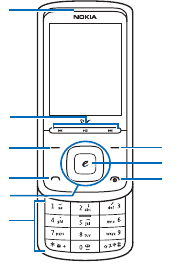
19
2. Your device
■Keys and parts (front)
1. Earpiece
2. Media keys
3. Left selection key
4. Call key
5. Navi™ key; hereafter
referred to as scroll key
6. Keypad
7. Power/End key
8. Middle selection key
9. Right selection key
6
1
5
8
9
7
3
4
2
Draft
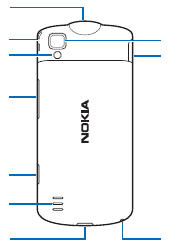
20
■Keys and parts (back)
1. Headset connector
2. Wrist strap eyelet
3. Flash
4. Volume keys
5. Camera key
6. Speaker
7. Release button
8. Microphone
9. Charger/USB port
10.Camera lens
10
8
9
2
4
5
3
6
1
7
Draft
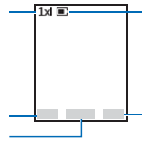
21
■Standby mode and shortcuts
Generally, instructions in this guide start from the standby
mode except when specifically indicated. To go to the
standby mode, press the power/end key.
Depending on your wireless service provider, some or all of
the following selection keys may appear in the standby
mode.
1. Signal strength — The signal
strength of the wireless
network at your current
location.
2. Battery level — The battery
charge level.
3. Menu — Press the left
selection key to access the main menu.
4. Go to — Press the right selection key to quickly access
a certain feature.
5. Web — Press the middle selection key to access mobile
internet service.
Shortcuts in the standby mode:
Go to Names
Menu
12
34
5
Draft
22
• To access the list of dialled numbers, press the call key
once.
• To switch between General profile and Silent profile,
press and hold # for at least three seconds.
• To activate the radio function, press and hold * for at
least three seconds.
• For shortcuts of scroll key, see "My shortcuts", p. 56.
■Active standby
To activate the active standby mode, scroll up in the
standby mode. To access a feature, scroll left or right to
select the feature and select Select. To end the active
standby navigation mode, select Exit.
To switch on the mode, select Menu > Settings > Display
> Active standby > Active standby mode.
To change the default application shortcuts, select
Menu > Settings > Display > Active standby > Personalise
view.
Draft
23
■Keyguard
Keyguard locks the keypad to prevent accidental key
presses.
When the keypad is locked, calls still may be possible to
the official emergency number programmed into your
device. Enter the emergency number, and press the call
key. The number is displayed only after you have entered
its last digit.
To lock the keypad automatically when no keys are
pressed for a certain time, in the standby mode, select
Menu > Settings > Phone > Automatic keyguard > On.
To lock the keypad, close the slide, and select Lock.
To unlock the keypad, open the slide or press Unlock then
press * within 2 seconds.
If you receive a call when the keypad is locked, it is
automatically unlocked, and then locked again when you
end the call.
Draft
24
3. Call functions
■Make a call
1. In the standby mode, enter the phone number,
including the country code and area code if necessary.
2. Press the call key.
3. To end the call or to cancel the call attempt, press the
end key.
■Answer or reject a call
To answer a call, press the call key or open the slide. To
reject an incoming call, press the end key.
Draft

25
■Conference call
Conference call (network service) allows you to take part
in a call with another two participants.
1. To call a third party during a call, select Options > New
call.
2. Enter the number you want, and press the call key.
3. When the new call is answered, press the call key.
4. To end the conference call, select Options > End all
calls, or press the end key.
■Loudspeaker
Warning: Do not hold the device near your ear
when the loudspeaker is in use because the
volume may be extremely loud.
To activate the loudspeaker during a call, select Loudsp.
To deactivate the loudspeaker, select Normal. When a
headset is connected, select Heads.
The loudspeaker is deactivated automatically when a call
(or a call attempt) ends or when certain accessories are
connected.
Draft

26
■Voice dialling
You can make a phone call by saying the name or the
number that is saved in the contact list of the device.
Voice tags are automatically created when a new contact
is added.
Note: Using voice tags may be difficult in a noisy
environment or during an emergency, so you
should not rely solely upon voice dialling in all
circumstances.
As voice commands are language-dependent, before voice
dialling, select Menu > Settings > Phone > Language
settings > Recogn. language and your language.
To activate voice dialling, press and hold the right
selection key or the volume key down. A short tone
sounds, and Say a command is displayed.
To deactivate voice dialling, press the end key.
To make a call by voice dialling, clearly say Call then the
name or the number of the contact you want to dial. If the
device recognises the name you spoke, it shows a list of
matches.
Draft
27
To listen to a voice tag, select Menu > Contacts > Names
> a contact > Details > contact name > Options > Play
voice tag.
Draft

28
4. Write text
The input methods available in the phone are preset
according to the market where it will be sold.
This phone supports simplified Chinese input methods.
To switch writing language, when writing text, press and
hold #, and select Writing language and the desired
language.
■Switch between input methods
Input method indicators are shown at the top of the
display:
Not all the methods may be available in all circumstances.
Always check the indicator to see which input method is
in use.
Pinyin Lower case
Stroke Number
input
Uppercase
Draft
29
To switch between available input methods, press #
repeatedly until the indicator of the desired input method
is displayed.
■Pinyin input method
The pinyin symbols are printed on the number keys. You
only need to press a key once, regardless of the position of
the symbol on the number key. The phone makes logical
combinations of the pinyin symbols.
To input a character using the pinyin input method:
1. Press the number key once for each pinyin symbol you
want to input (use "v" for "u").
2. Press 1 repeatedly until you get the desired tone mark.
3. If necessary, press * repeatedly to highlight the desired
pinyin combination.
4. Scroll to the desired Chinese character, and select OK.
■Stroke input method
The strokes constituting Chinese characters have been
divided into five categories: horizontal, vertical, left-
Draft
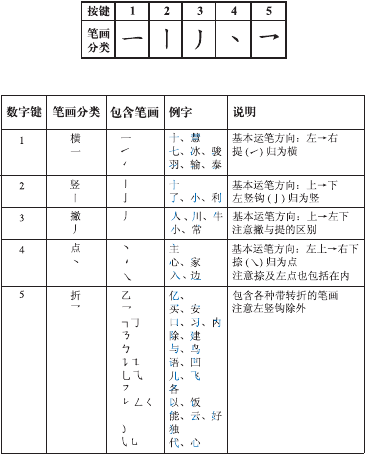
30
falling, dot, and turning. Each category corresponds to a
number key from 1 to 5, respectively.
The strokes are classified according to the following table:
Draft

31
To use the stroke input method:
1. In the standard stroke order, press the number keys to
input the strokes.
Tip: if you are not sure which stroke to use or
which category it belongs to, press 6 to
substitute that stroke, then continue with the
subsequent strokes. A question mark appears in
the input area to represent that stroke.
2. Scroll to the desired Chinese character, and select OK.
■Phrase input
You may input a phrase of no more than seven Chinese
characters at a time.
1. Press the relevant number keys to enter the syllable or
pinyin initial, or first strokes for the first character of
the phrase.
2. Press 0 to enter a separator; or, if in the pinyin mode,
press 1 repeatedly to enter the tone mark of the
character you want.
3. Enter the syllable or pinyin initial, or first strokes of the
next Chinese character.
Draft
32
4. Repeat step 2 and 3, if necessary, to enter the syllables
or pinyin initials, or first strokes of all the characters in
the phrase.
5. If in the pinyin mode, press * repeatedly, if necessary,
to highlight the pinyin combination you want.
6. Scroll through the candidate list to the desired phrase,
and select OK.
Not all phrases are stored in your phone. To create a
phrase of no more than seven characters, when no input
symbol or prediction list is displayed, select Options >
User phrases > Add. When the database becomes full, the
new phrase replaces the phrase that has not been
accessed for the longest time.
Use a separator to separate pinyin strings for syllables of
different characters or the strokes of different characters.
When you enter a separator, the phone predicts
characters or character strings that can form a phrase
with the possible candidates of the combination of pinyin
or stroke strings and separators, if any, that you have
entered.
Draft
33
■Set predictive English input on and off
When writing text in English, to switch predictive text
input on or off, press and hold #, and select Prediction on
or Prediction off.
■Traditional English input
Press a number key, 2 to 9, repeatedly until the desired
character appears.
If the next letter you want is located on the same key as
the present one, wait until the cursor appears, or scroll
right, and enter the letter.
Not all characters available under a number key are
printed on the key. The available characters depend on the
selected Writing language.
The most common punctuation marks and special
characters are available under the number key 1. To
access the list of special characters, press *.
■Predictive English input
Draft
34
Predictive English input is based on a built-in dictionary to
which you can also add new words.
1. Start writing a word using the keys 2 to 9. Press each
key only once for one letter.
2. To confirm a word, scroll right or add a space.
• If the word is not correct, press * repeatedly until
the desired word appears, and confirm it.
• If the ? character is displayed after the word, the
word you intended to write is not in the dictionary.
To add the word to the dictionary, select Spell.
Enter the word using traditional text input, and
select Save.
• To write compound words, enter the first part of the
word, and scroll right to confirm it. Write the last
part of the word, and confirm the word.
3. Start writing the next word.
■Tips for writing text
The following functions may also be available for writing
text:
Draft
35
• To insert a number when no input symbol is displayed,
press and hold the desired number key.
• To insert a space when there is no candidate or
prediction list displayed, press 0.
• To enter a special character after you have finished
entering a word or character, press *.
• To repeat a character to the left of the cursor in the
editing window, press and hold *.
• To end the Chinese character prediction, select Back,
or press the relevant keys to start entering new text.
Draft
36
5. Voice commands
■Activate and use voice commands
To activate voice command, in the standby mode, press
and hold the volume key down or the right selection key.
The following options are listed:
• Call <Name or #> — to make a call, say "Call" and
followed by a name or a phone number from Contacts
• Send Text <Name or #> — to send a text message, say
"Send text" and followed by a name or a phone number
from Contacts
• Send MMS <Name or #> — to send an MMS, say "Send
MMS" and followed by a name or a phone number
from Contacts
• Lookup <Name> — to retrieve and display information
of a contact, say "Lookup" and followed by the name
from Contacts
• Go To <Menu> — to activate certain device function,
say "Go to" and followed by the application name. For
Draft
37
the list of functions to be activated with a voice
command, see "Voice commands", p. 62.
• Check <Item> — to check the status, say "Check" and
followed by the specific status item or say "Check
status" to hear all the status information for your
device
To learn how to use the voice recognition, select Tutorial.
■Voice commands settings
To personalise settings for your voice command functions,
select Settings and from the following options:
•Confirmation — to set how often the system asks you
to confirm the name or number
•Adaptation — to adapt the system to your voice for
optimal recognition accuracy
•Modes — to set the level of audio guidance
•Speakerphone — to set how the system uses the
speakerphone
Draft

38
6. Menu functions
The device functions are grouped into menus. Not all
menu functions or option items are described here.
In the standby mode, select Menu, scroll to the menu item
you want to open, and select it. To exit the current menu
level, select Exit or Back. To return to the standby mode,
press the end key.
■Messaging
You can only use messaging services supported by
your network or service provider.
Write and send a text message
1. Select Menu > Messaging > Text messages > Create
message.
2. Enter the recipient’s phone number in the To field. To
retrieve a phone number from the recently used
recipients list of your contacts, select Add > Recently
used or Contacts, the recipient, and Select. To send to a
Draft

39
contact group, select Add > Contact groups, the group,
and Select.
3. Write the message in the Message field, and select
Send.
Write and send a multimedia message
To check availability and to subscribe to the multimedia
messaging service (network service), contact your service
provider.
Only devices that have compatible features can receive
and display multimedia messages. The appearance of a
message may vary depending on the receiving device.
The wireless network may limit the size of MMS messages.
If the inserted picture exceeds this limit, the device may
make it smaller so that it can be sent by MMS.
To send a multimedia message, do the following:
1. Select Menu > Messaging > Multim. Messages >
Create message.
2. Select Options > Add object, a multimedia folder and
the file you want to send.
3. Select Insert to insert the files into the message.
Draft

40
4. Press Options > Add another object, to select the
second or third files.
5. Enter the phone number or e-mail address for your
recipient, or select Add to retrieve a number or address
from the contact list.
6. Enter the text for the message and select Send.
Read and reply to a message
When you receive a message, a notification and are
displayed.
1. Select Show to read the message or Exit to dismiss the
notification.
in the standby mode indicates that you have
unread messages in your inbox.
2. Select Reply and from the available options.
3. Enter your reply, and select Send.
Text message settings
Select Menu > Messaging > Text messages > Message
settings.
Draft
41
Select Sending options and from the following:
•Priority — to send text messages with normal priority
or as urgent
•Delivery reports — to receive confirmation when your
message is delivered
•Send callback number — to send a number to which
you want to be called back
•Signature — to attach a signature to outgoing message
•Message validity — to select the period of validity of a
messaging request (network service)
Select Other settings and from the following:
•Save rcvd. text msgs. — to select where to store
received messages
•Message font size — to change the font size when
reading and writing messages
•Message overwriting — When the message memory is
full, your device cannot receive any new messages. To
select which messages are overwritten when new ones
arrive, select Sent items only, Inbox only, or S. items &
Inbox.
Draft

42
•Save sent messages — to select whether to save,
always save, or always prompt to save sent messages
to the Sent items folder
•Queue if no digital— to select whether to store
messages that failed to send in the Outbox folder
Select Memory status to view available and used memory.
Multimedia messages settings
Select Menu > Messaging > Multim. Messages >
Message settings and from the following:
•Save sent messages — to select whether the
multimedia messages you send are saved to the Sent
items folder
•Delivery reports — to select whether to receive
message delivery reports
•Default slide timing — to set the default time for slides
in multimedia messages
•Allow MMS receptn. — to select whether to receive
multimedia messages. To only receive multimedia
messages when you are in your home network, select
Draft

43
In home network (network service). For more
information, contact your service provider.
•Incoming MMS msgs. — to select whether incoming
multimedia messages are retrieved automatically or
manually, or not at all
•Allow adverts — to select whether to block or allow
advertisements (network service) sent as multimedia
messages; For more information, contact your service
provider.
•Message validity — to select how long the message
centre tries to send your message if the first attempt
fails, if the recipient cannot be reached within the
validity period, the message is deleted from the
message centre
•Connection settings — to define connection settings
•Memory status — to view available and used memory
Inbox, Sent items, and Drafts folders
All incoming text and multimedia messages are saved in
the Inbox folder. The Outbox folder contains unsent and
failed messages.
Draft

44
If you have set the device to save the sent messages, they
are saved in the Sent items folder.
To save the message you are writing to the Draft folder to
edit and send later, select Options > Save as draft (text
message) or Save message (multimedia message).
Delete messages
If your message memory is full and you have incoming
messages, blinks in the standby mode. To receive the
messages, delete some of the old messages.
To delete a message, select Menu > Messaging > Text
messages or Multim. Messages, the message location, the
message, and Options > Delete > Yes.
To delete all text messages in a folder, select Menu >
Messaging > Text messages > Delete messages > All, All
read, All unread and the folder.
To delete all multimedia messages in a folder, select
Menu > Messaging > Multim. Messages > Delete
messages and the folder.
Draft

45
Voice messages
To activate voice mail (network service), contact your
service provider. When you subscribe to the service, you
receive voice mailbox number. Save the number to your
device. For more information, contact your service
provider.
To listen to your voice messages, select Menu >
Messaging >Voice messages >Listen to voice msgs., or
press and hold 1 in the standby mode.
Browser messages
Browser (network service) allows you to check your e-mail
messages with your device. For more information, see
"Network services", p. 9.
Select Menu > Messaging > Browser msgs.
Important: Exercise caution when opening
messages. Messages may contain malicious
software or otherwise be harmful to your device
or PC.
Draft

46
QQ
QQ (network service) allows you to converse with other
people using instant messages. To check more information
about signing up and costs of QQ service, contact your
service provider.
Select Menu > Messaging > QQ.
E-mail mailbox
E-mail mailbox (network service) allows you to set up your
e-mail account and check e-mail messages on your
device. For more information, see "Network services", p. 9.
Select Menu > Messaging > E-mail mailbox
Important: Exercise caution when opening
messages. Messages may contain malicious
software or otherwise be harmful to your device
or PC.
Groups
Groups allow you to send messages to a designated group
of people.
Draft

47
To add a new group, select Menu > Messaging > Groups >
Add, the detail for the group, and Save.
■Contacts
Search using the search command
1. Select Menu > Contacts > Names > Options > Search.
2. Enter the first characters or letters of the name you are
searching for, and select Details.
Search using the pop-up window
1. In the standby mode, scroll down to highlight the first
name (or number).
2. Enter the first input symbol of the name you are
searching for. The symbol is displayed in a pop-up
window. If you want, enter more symbols in the pop-
up window. The matching names are displayed. The
listed names may not be in the same order as in
Names. When using the Search command or pop-up
window, to change the input method, press #.
Draft

48
To edit the detail, set speed dial, or add to group, highlight
the contact, and select Details >Options.
To define how the contact names are displayed, select
Menu > Contacts > Settings and from the available
options. To view how much memory your contacts
information is using, select Memory status.
To empty your contacts list, select Menu > Contacts >
Del. all contacts.
Groups
Groups allow you to send messages to a designated group
of people.
To add a new group, select Menu > Contacts > Groups >
Add, the detail for the group, and Save.
Speed dials
You can associate a speed dialling slot from 2 to 99 with
an entry in the contact list. To activate or deactivate speed
dialling, see "Call", p. 58.
To assign a phone number to a speed dialling slot, select
Menu > Contacts > Speed dials > an empty speed dialling
Draft

49
slot, and Assign. Enter the phone number you want to
assign to the key, or select Search to retrieve the number
from your contacts.
■Log
To view the information on your calls, select
Menu > Log.
•Call log — to view all of the numbers chronologically
•Missed calls, Received calls, or Dialled numbers — to
view your most recent missed or received calls or
dialled numbers
•Msg. recipients — to view the contacts to whom you
most recently sent messages
•Clear log lists — to delete calls from the log
•Call duration — to view the approximate duration of
calls; to reset the timers, select Clear timers, enter your
lock code, and select OK
Note: The actual time invoiced for calls by your
network service provider may vary, depending on
network features, rounding off for billing, and so
forth.
Draft

50
•Data/fax calls or Browser calls — to view the duration
or amount of data sent or received during data calls
(network service) or using the browser (network
service)
•Positioning — to view the list of the most recent
position notifications and requests (network service)
■esurfing
You can download music and videos with mobile
internet services. Check the availability of these services,
pricing, tariffs, and instructions with your service
provider.
■Web
You can access various mobile internet services
with your phone browser. Check the availability of these
services, pricing, tariffs, and instructions with your service
provider.
Important: Use only services that you trust and
that offer adequate security and protection
against harmful software.
Draft

51
■Best Tone
Best Tone provides you with such information as
food and beverage availability, tourist advice, road guide,
and hotel reservation. Check the availability of these
services, pricing, tariffs, and instructions with your service
provider.
■Customer Service
You can access various customer services provided
by your service provider. Accessing these services may
involve sending messages or making a phone call for
which you may be charged. For more details, contact your
service provider.
■Settings
Profiles
Profiles define how your device reacts when you receive a
call or message, and how your keypad sounds when you
press a key. You can personalise ringing options, keypad
tones, and other settings for each of the available profiles.
Draft

52
The available profiles are: General, Silent, Meeting,
Outdoor, Flight, and two customisable ones.
To activate or customise a profile or set a time limit for a
profile, select Menu > Settings > Profiles, a profile, and
Activate, Personalise, or Timed.
Blog site
Blog site defines web address where you can upload your
pictures or videos.
To add a blog site, select Menu > Settings > Blog site >
Add, enter the detail of the site, and Save.
Themes
A theme contains various elements for personalising your
device.
To change the theme for your device, select Menu >
Settings > Themes, a theme, and Apply.
Tones
Tone settings only apply to the currently selected profile.
Draft
53
Select Menu > Settings > Tones and from following:
•Incoming call alert — to set the alert type for incoming
calls
•Ringing tone — to set the tone for incoming calls
•Ringing volume — to set the volume level for the
ringing tone and message alert tone
•Incoming call video — to set a video clip to be played
when you receive call
•Vibrating alert — to set the device to vibrate when you
receive a call or a text message
•Message alert tone — to set the tone to sound when
you receive a text message
•Keypad tones — to select the volume level of the
keypad tones
•End of list tone — to set a tone to sound when you are
at the end of a menu list, contact list, or calls list
•Other tones — to select a tone for other functions
•Application tones — to set the application default tone
•Alert for — to set the device to alert for all calls or only
when a member of a selected caller group calls
Draft

54
Light settings
To turn the light of the media key on or off, select Menu >
Settings > Light settings > Light effects.
Display
Select Menu > Settings > Display and from the following
options:
•Wallpaper — to set a background image that is
displayed when the device is in the standby mode
•Standby font colour — to set the font colour for text
shown in the standby mode
•Screen saver — to set a screen saver for the display
•Slide animation — to set an animation shown when
opening and closing the slide
•Power saver — to select the power saver for saving
battery
•Sleep mode — to turn the phone display off during
inactivity
•Font size — to select the font size for display text
Draft

55
•Backlight time-out — to define how long the backlight
remains on
•Active standby — to switch the active standby mode on
or off, to organise and personalise the active standby
mode, and to set the active standby keys
•Navigation key icons — to display the icons of the
current scroll key shortcuts in the standby mode when
the active standby mode is off
•Transition effects — to turn transition effect on or off
Date and time
Select Menu > Settings > Date and time and from the
following:
•Date and time — to set the date and time, time zone,
and daylight saving time
•Date and time format — to set the format for the date
and time
•Auto-update of time — to select if the time in your
phone is automatically updated to local time by the
network
Draft

56
My shortcuts
To quickly access your most frequently used functions,
add them to the My shortcuts menu.
To select a function from the list for the key you want to
assign the shortcut to, select Menu > Settings > My
shortcuts, the key, the function, and Select.
Connectivity
Bluetooth connection
This device is compliant with Bluetooth Specification 2.0
with EDR and supports the following profiles: Advance
Audio Distribution Profile, A/V Remote Control, Basic
Printing Profile, Dial-up Networking, File Transfer Profile,
Generic A/V Dist. Profile, Hands Free Profile, Headset
Profile, Object Push Profile, and Phone Book Access
Profile. To ensure interoperability between other devices
supporting Bluetooth technology, use Nokia approved
accessories for this model. Check with the manufacturers
of other devices to determine their compatibility with this
device.
Draft
57
• Operating the device in hidden mode is a safer way to
avoid malicious software.
• Do not accept Bluetooth connectivity from sources you
do not trust.
• Alternatively, switch off the Bluetooth function. This
does not affect other functions of the device.
To activate Bluetooth connectivity, select Menu >
Settings > Connectivity > Bluetooth > Bluetooth > On.
To connect an audio device using Bluetooth technology,
select Menu > Settings > Bluetooth > Conn. to audio acc.
To pair your phone with any Bluetooth device in range,
select Paired devices > Add new device > a device > Add.
Enter a password on your phone and allow the connection
on the other Bluetooth device.
To see a list of your Bluetooth connections, select Active
devices.
To define how your device is shown to other Bluetooth
devices, select My phone’s visibility or My phone’s name.
Features using Bluetooth technology increase the demand
on battery power and reduce the battery life.
Draft

58
USB data cable
You can transfer data between your device and a
compatible PC using a CA-101 USB data cable.
Important: To make a phone call, disconnect the
USB data cable.
To activate your device for data transfer, connect the data
cable, select from the following modes:
•PC Suite — to use the data cable connection for Nokia
PC Suite
•Data storage — to connect to a PC that does not have
Nokia software and use your device for data storage
•Media transfer — to connect the device to a PC to
synchronise it with Windows Media Player
•Ask on connection — to be asked for the purpose of the
connection each time when the cable is connected
Call
Select Menu > Settings > Call and from the following
options:
Draft
59
•Anykey answer — to answer an incoming call by
pressing any key except the call key or the left
selection key
•Automatic redial — to automatically redial a number
after an unsuccessful call attempt
•Speed dialling — to select whether the number keys (2-
99) can be used for calling a number by pressing and
holding the key
•Calling card — to save up to four calling card numbers
in your device to use for long distance calls
•Abbreviated dialling — to program a five- or six digits
prefix for commonly used phone numbers
•Preferred carrier — to select the preferred long
distance carrier
•International prefix — to make calls using the + sign as
the international prefix. The device replaces the + sign
in a saved phone number when making a call
•Data/fax calls — to set your device to send or receive
data calls when connected to a device such as a PDA or
PC
Draft

60
•Call summary — to display the call duration when you
end a call
•Show call time displ. — to select whether the duration
of the current call is displayed
•Ringtone no caller ID — to set whether a tone sounds
for calls where there is no caller ID
•Location info sharing — to set whether to share the
location information of the phone with the network
•Message response — to set your device to send a text
message when a call is rejected
•Slide call handling — to set whether to answer a call by
opening the slide and whether to end a call by closing
the slide
Device
Select Menu > Settings > Phone and from the following
options:
•Language settings — to set the display language of
your device, select display Phone language. To set a
language for voice commands, select Recogn.
language.
Draft
61
•Memory status — to view the free memory and used
memory of your device
•Automatic keyguard — to set the keypad to lock
automatically after a preset time delay
•DTMF tones — to set the tone duration when you press
the keys on your device keypad
•Start-up tone and Switch off tone — to select whether
the device sounds a tone when it is switched on or off
•Welcome note — to write a welcome note that appears
when you switch your device on
•Phone updates — to update the phone with the latest
software available
•Help text activation — to display brief descriptions for
most menu items
•Flight query — to be asked if the Flight profile should
be used each time the device is switched on
•Gateway settings — to select the gateway for web
browsing
•BREW EFS enable — to select whether to allow BREW
EFS downloads
Draft

62
•PPP Setting — to set WAP and BREW settings
•WAP Pull Position — to select action to take when pull
messages are available from the network
Voice commands
You can use voice commands to control your device.
Voice commands are language-dependent. To set the
language, see "Device", p. 60.
Enhancements
Select Menu > Settings > Enhancements, an
enhancement, and an option depending on the
enhancement.
Security
To set the security settings for your device, select Menu >
Settings > Security, enter lock code, and from the
available options.
The default lock code is 1234.
Draft

63
Network
The Network menu allows you to customise how your
device chooses which network to operate in while you are
within or away from your primary or home system. Your
device is set to search for the most effective network. To
set which network to use when the device cannot find a
preferred network, select Menu > Settings > Network >
Set mode, and select a mode.
Network services
To view the network services available on your device,
select Menu > Settings > Network services and from the
available options. For more information, contact your
service provider.
Device information
To view the user, version, system, or icon information of
your device, select Menu > Settings > Phone details, and
the corresponding option.
Draft

64
Restore settings
Select Menu > Settings > Rest. factory sett. and from the
following options:
•Restore settings only — to reset some of the menu
setting to their original signal
•Restore all — to restore all settings and delete personal
data
■Gallery
Manage images, video clips, music files, themes,
graphics, tones, recordings, and received files. These files
are stored in the phone memory or on a memory card, and
may be arranged in folders.
When a memory card is inserted, a folder with the memory
card appears on the list. Select the folder to view the
memory card contents.
To see the list of folders, select Menu > Gallery. To see the
available options of a folder, select a folder and Options.
To view the list of files in a folder, select a folder and
Open. To see the available options of a file, select a file
and Options.
Draft

65
Content owners may use different types of digital rights
management (DRM) technologies to protect their
intellectual property, including copyrights. This device
uses various types of DRM software to access DRM-
protected content. With this device you can access
content protected with OMA DRM 1.0. If certain DRM
software fails to protect the content, content owners may
ask that such DRM software's ability to access new DRM-
protected content be revoked. Revocation may also
prevent renewal of such DRM-protected content already
in your device. Revocation of such DRM software does not
affect the use of content protected with other types of
DRM or the use of non-DRM-protected content.
Digital rights management (DRM) protected content
comes with an associated activation key that defines your
rights to use the content.
■Media
Camera and Video
You can take photos and record video clips with the built-
in camera. The camera lens is on the back of the device.
Draft
66
Your device supports image capture resolutions of up to
1024x1280 pixels. The camera produces images in JPEG
format.
Your device supports image capture resolutions of up to
144x176 pixels. The video clips are saved in 3GP format.
You can send images in a multimedia message. You can
also attach an image to a contact to be displayed when
the contact calls you.
Capture an image
In the standby mode, select Menu > Media > Camera or
press the camera key.
Keep a safe distance when using the flash. Do not use the
flash on people or animals at close range. Do not cover the
flash white taking a picture.
To capture an image, press the camera key or Capture. The
image is saved in the Image folder in Gallery. To capture
another image, select Back. To send the image as a
message, select Send. To view more options, select
Options.
Record a video clip
In the standby mode, select Menu > Media > Video.
Draft
67
To record a video clip, press the camera key, or select
Record. To adjust the camera zoom level, press the scroll
key or volume key up and down. The video clip is saved in
the Recordings folder in Gallery. To record another video
clip, select Back. To send the video clip in a message,
select Options > Send. To view more options, select
Options.
Camera and Video options
In the standby mode, select Menu > Media > Camera or
Video > Options and from the following:
•Video or Still image — to switch the capture mode to
video or photo
•Brightness — to change the brightness setting
•Standard photo or Portrait photo — to switch the
capture mode to landscape or portrait
•Flash on or Flash off — to switch the flash on or off
•Self-timer — to use the self-timer to include yourself in
the picture. Select the time for the camera to wait
before capturing the image after you press the camera
key.
Draft

68
•Img. sequence on and Img. sequence off — to capture
three images in succession
•Mute — to record a video clip without sound
•Effects — to adjust the camera filters
•White balance — to change the white balance setting
•View previous — to display the last captured image
•Settings — to change the camera or video settings
Media player
The media player supports the following audio formats:
midi, CMX codes, mp3, aac, qcelp, amr-nb, wma, aac+,
and eaac+; and the following video formats: mpeg4,
H.263, and H.264.
Download, view, and play compatible images, audio and
video files, and animated images from a variety of sources.
Warning: Listen to music at a moderate level.
Continuous exposure to high volume may
damage your hearing. Do not hold the device near
your ear when the loudspeaker is in use, because
the volume may be extremely loud.
Draft
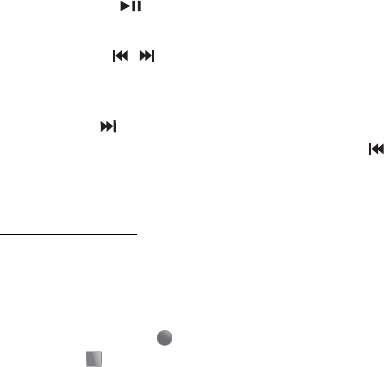
69
To open a file, select Menu > Media > Media player, a
multimedia folder, Open, and the file you want to play,
and Play.
To start or pause playback, press the middle selection key
or the media key .
To fast-forward or rewind playback, press and hold scroll
key left/right or / . Release the key at the position you
want to continue the playback.
To skip to the next track or file, press the scroll key right or
the media key . To skip to the beginning of the previous
track or file, press the scroll key left or the media key .
To close media player, press the end key.
Voice recorder
Record speech or sound with your device and listen to
them later. You can record up to 5 minutes of sound,
depending on the available memory.
To start recording, select Menu > Media > Voice recorder,
and the record button . To stop recording, select the
stop button . The file is saved in the Recordings folder
in Gallery.
Draft
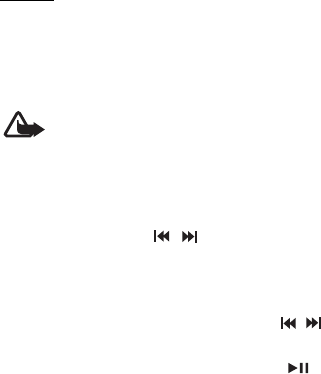
70
After you save a recording, select Options > Play last
recorded, Send last recorded, Recordings list, or Select
memory.
Radio
The FM radio depends on an antenna other than the
wireless device antenna. A compatible headset or
accessory must be attached to the device for the FM radio
to function properly.
Warning: Listen to music at a moderate level.
Continuous exposure to high volume may
damage your hearing.
To listen to the radio, select Menu > Media > Radio.
To start channel search, press and hold the scroll key left/
right or the media key / . To search for available
stations, select Options > Search all stations. To save the
channel to a memory location, select Options > Save
station. To go to the next or previously saved station, press
the scroll key up/down or the media key / . To access
more options while listening to a channel, select Options.
To turn the radio off, press the media key or select
Options > Switch off.
Draft

71
Equaliser
The equaliser enhances the sound quality when using the
music player.
To use a preset setting when playing music, select Menu >
Media > Equaliser > an equaliser set > Activate.
To view a setting, select the setting, Options, and from the
available options.
■Organiser
Alarm clock
The alarm clock is based on the device clock. A set alarm
will sound even when the device is switched off.
Select Menu > Organiser > Alarm Clock.
•Alarm — to turn on or off the alarm
•Alarm time — to set the alarm time
•Repeat — to set to repeat the alarm
•Repeat days — to set the device to alarm on selected
days of the week if Repeat is set to On
•Alarm tone — to select a tone for this alarm
Draft

72
•Snooze time-out — to select the snooze time out from
2 to 59 minutes
When the alarm sounds, select Stop to shut the alarm off,
or Snooze to postpone it.
Calendar
To open the calendar, select Menu > Organiser >
Calendar. To go to a specific date, select Options in the
calendar view and Go to date, enter the date, and select
OK.
Lunar calendar
To use the lunar calendar, the phone language must be
Chinese.
To view lunar details of the highlighted day, in the month
view, select Options > Lunar calendar.
To search for a lunar festival, in the lunar day view, select
Lunar festival, enter the Gregorian year of the Spring
festival, and select the desired lunar festival.
In the lunar day view, select Options and from the
following:
Draft

73
•Solar item — to search for a solar item
•Gregorian to lunar — to convert a Gregorian date to a
lunar date
•Lunar to gregorian — to convert a lunar date to a
Gregorian date
Notes
To add a note, select Menu > Organiser > Notes > Add
note. Enter the note, and select Save.
Calculator
The calculator in your device provides basic arithmetic
functions, converts currency values, and calculates the
square, the square root, and the inverse of a number.
Note: This calculator has limited accuracy and is
designed for simple calculations.
1. Select Menu > Organiser > Calculator.
2. Enter the first number in the calculation. Press # for a
decimal point, if necessary.
Draft

74
Press * repeatedly to add the add (+), subtract (-),
multiply (*), or divide (/) operator. Pause briefly to
select the displayed character.
3. Enter the second number in your calculation. To
display the result, select Equals. To perform a square or
square root calculation after, select Options > Square
or Square root.
Dictionary
In Dictionary, you can look up a Chinese word for English
translation, and look up an English word for Chinese
translation.
1. Select Menu > Organiser > Dictionary.
2. Switch to the desired input mode if necessary.
3. Enter the Chinese or English word.
4. Scroll to desired word in the displayed list of words,
and select it to view the translation.
To view the translation of the previous or next word in the
displayed list of words, scroll left or right.
Draft

75
■Extras
Select Menu > Extras.
To play a game in your device, select Games.
To set or view the time in a different location, select
Collection > World clock.
To calculate exchange rates, select Collection > Converter.
Draft

76
7. Accessories
For availability of approved accessories, please check with
your dealer. When you disconnect the power cord of any
accessory, grasp and pull the plug, not the cord.
Warning: Use only batteries, chargers, and
accessories approved by Nokia for use with this
particular model. The use of any other types may
invalidate any approval or warranty, and may be
dangerous.
Draft
77
8. Battery and charger information
Your device is powered by a rechargeable battery. The
battery intended for use with this device is BL-4C Li-lon
battery. This device is intended for use when supplied with
power from the following charger: AC-6U. The exact
charger model number may vary depending on the type of
plug. The plug variant is identified by one of the following:
E, EB, X, AR, U, A,C or UB.
The battery can be charged and discharged hundreds of
times, but it will eventually wear out. When the talk and
standby times are noticeably shorter than normal, replace
the battery. Use only Nokia approved batteries, and
recharge your battery only with Nokia approved chargers
designated for this device. Use of an unapproved battery
or charger may present a risk of fire, explosion, leakage, or
other hazard.
If a battery is being used for the first time or if the battery
has not been used for a prolonged period, it may be
necessary to connect the charger, then disconnect and
reconnect it to begin charging the battery. If the battery is
completely discharged, it may take several minutes before
Draft
78
the charging indicator appears on the display or before
any calls can be made.
Always switch the device off and disconnect the charger
before removing the battery.
Unplug the charger from the electrical plug and the device
when not in use. Do not leave a fully charged battery
connected to a charger, since overcharging may shorten
its lifetime. If left unused, a fully charged battery will lose
its charge over time.
Always try to keep the battery between 15°C and 25°C
(59°F and 77°F). Extreme temperatures reduce the
capacity and lifetime of the battery. A device with a hot or
cold battery may not work temporarily. Battery
performance is particularly limited in temperatures well
below freezing.
Do not short-circuit the battery. Accidental short-
circuiting can occur when a metallic object such as a coin,
clip, or pen causes direct connection of the positive (+)
and negative (-) terminals of the battery. (These look like
metal strips on the battery.) This might happen, for
example, when you carry a spare battery in your pocket or
Draft
79
purse. Short-circuiting the terminals may damage the
battery or the connecting object.
Do not dispose of batteries in a fire as they may explode.
Batteries may also explode if damaged. Dispose of
batteries according to local regulations. Please recycle
when possible. Do not dispose as household waste.
Do not dismantle, cut, open, crush, bend, deform,
puncture, or shred cells or batteries. In the event of a
battery leak, do not allow the liquid to come in contact
with the skin or eyes. In the event of such a leak, flush
your skin or eyes immediately with water, or seek medical
help.
Do not modify, remanufacture, attempt to insert foreign
objects into the battery, or immerse or expose it to water
or other liquids.
Improper battery use may result in a fire, explosion, or
other hazard. If the device or battery is dropped, especially
on a hard surface, and you believe the battery has been
damaged, take it to a service centre for inspection before
continuing to use it.
Draft

80
Use the battery only for its intended purpose. Never use
any charger or battery that is damaged. Keep your battery
out of the reach of small children.
■Battery information
This section provides information about battery charging times
with the travel charger (AC-6U), and talk and standby times. The
information in this section is subject to change. For more
information, contact your service provider.
Important: Battery talk and standby times are
estimates only and depend on signal strength,
network conditions, features used, battery age
and condition, temperatures to which battery is
exposed, use in digital mode, and many other
factors. The amount of time a device is used for
calls will affect its standby time. Likewise, the
amount of time that the device is turned on and
in the standby mode will affect its talk time.
Charging times
The following charging times are approximate:
Draft

81
Talk and standby times
■Nokia battery authentication
guidelines
Always use original Nokia batteries for your safety. To
check that you are getting an original Nokia battery,
purchase it from a Nokia authorised service centre or
dealer, and inspect the hologram label using the following
steps:
Charger AC-6U
BL-4C Li-Ion battery Up to 3.5 hours
Function Digital
Talk time Up to 4 hours
Standby time Up to 11 days
Draft
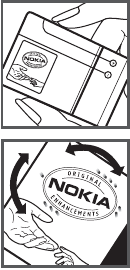
82
Authenticate hologram
1. When you look at the hologram
on the label, you should see the
Nokia connecting hands symbol
from one angle and the Nokia
Original Accessories logo when
looking from another angle.
2. When you angle the hologram
left, right, down, and up, you
should see 1, 2, 3 and 4 dots on
each side respectively.
Successful completion of the steps is not a total assurance
of the authenticity of the battery. If you have any reason
to believe that your battery is not an authentic, original
Nokia battery, you should refrain from using it, and take it
to the nearest authorised Nokia service centre or dealer
for assistance. If authenticity cannot be verified, return
the battery to the place of purchase.
Draft

83
What if your battery is not authentic?
If you cannot confirm that your Nokia battery with the
hologram on the label is an authentic Nokia battery,
please do not use the battery. Take it to the nearest
authorised Nokia service centre or dealer for assistance.
The use of a battery that is not approved by Nokia may be
dangerous and may result in poor performance and
damage to your device and its accessories. It may also
invalidate any approval or warranty applying to the
device.
To find out more about original Nokia batteries, visit
www.nokia.com/battery.
Draft
84
Care and maintenance
Your device is a product of superior design and craftsmanship and
should be treated with care. The following suggestions will help
you protect your warranty coverage.
• Keep the device dry. Precipitation, humidity, and all types of
liquids or moisture can contain minerals that will corrode
electronic circuits. If your device does get wet, remove the
battery, and allow the device to dry completely before
replacing it.
• Do not use or store the device in dusty, dirty areas. Its moving
parts and electronic components can be damaged.
• Do not store the device in hot areas. High temperatures can
shorten the life of electronic devices, damage batteries, and
warp or melt certain plastics.
• Do not store the device in cold areas. When the device returns
to its normal temperature, moisture can form inside the
device and damage electronic circuit boards.
• Do not attempt to open the device other than as instructed in
this guide.
• Do not drop, knock, or shake the device. Rough handling can
break internal circuit boards and fine mechanics.
Draft
85
• Do not use harsh chemicals, cleaning solvents, or strong
detergents to clean the device.
• Do not paint the device. Paint can clog the moving parts and
prevent proper operation.
• Use a soft, clean, dry cloth to clean any lenses, such as
camera, proximity sensor, and light sensor lenses.
• Use only the supplied or an approved replacement antenna.
Unauthorised antennas, modifications, or attachments could
damage the device and may violate regulations governing
radio devices.
• Use chargers indoors.
• Always create a backup of data you want to keep, such as
contacts and calendar notes.
• To reset the device from time to time for optimum
performance, power off the device and remove the battery.
These suggestions apply equally to your device, battery, charger,
or any accessory. If any device is not working properly, take it to
the nearest authorised service facility for service.
Draft

86
Disposal
The crossed-out wheeled-bin symbol on your product,
literature, or packaging reminds you that all electrical and
electronic products, batteries, and accumulators must be
taken to separate collection at the end of their working
life. This requirement applies to the European Union and
other locations where separate collection systems are
available. Do not dispose of these products as unsorted
municipal waste.
By returning the products to collection you help prevent
uncontrolled waste disposal and promote the reuse of
material resources. More detailed information is available
from the product retailer, local waste authorities, national
producer responsibility organizations, or your local Nokia
representative. For the product Eco-Declaration or
instructions for returning your obsolete product, go to
country-specific information at www.nokia.com.
Draft
87
Additional safety information
■Small children
Your device and its accessories may contain small parts. Keep
them out of the reach of small children.
■Operating environment
This device meets RF exposure guidelines when used either in the
normal use position against the ear or when positioned at least
2.2 centimetres (7/8 inch) away from the body. When a carry
case, belt clip, or holder is used for body-worn operation, it
should not contain metal and should position the device the
above-stated distance from your body.
To transmit data files or messages, this device requires a quality
connection to the network. In some cases, transmission of data
files or messages may be delayed until such a connection is
available. Ensure the above separation distance instructions are
followed until the transmission is completed.
Parts of the device are magnetic. Metallic materials may be
attracted to the device. Do not place credit cards or other
magnetic storage media near the device, because information
stored on them may be erased.
■Medical devices
Draft

88
Operation of any radio transmitting equipment, including
wireless phones, may interfere with the functionality of
inadequately protected medical devices. Consult a physician or
the manufacturer of the medical device to determine if they are
adequately shielded from external RF energy or if you have any
questions. Switch off your device in health care facilities when
any regulations posted in these areas instruct you to do so.
Hospitals or health care facilities may be using equipment that
could be sensitive to external RF energy.
Implanted medical devices
Manufacturers of medical devices recommend that a minimum
separation of 15.3 centimetres (6 inches) should be maintained
between a wireless device and an implanted medical device, such
as a pacemaker or implanted cardioverter defibrillator, to avoid
potential interference with the medical device. Persons who have
such devices should:
• Always keep the wireless device more than 15.3 centimetres
(6 inches) from the medical device when the wireless device is
turned on.
• Not carry the wireless device in a breast pocket.
• Hold the wireless device to the ear opposite the medical
device to minimise the potential for interference.
Draft

89
• Turn the wireless device off immediately if there is any reason
to suspect that interference is taking place.
• Read and follow the directions from the manufacturer of their
implanted medical device.
If you have any questions about using your wireless device with
an implanted medical device, consult your health care provider.
Hearing aids
Some digital wireless devices may interfere with some hearing
aids. If interference occurs, consult your service provider.
Warning: For hearing aid compatibility, you must turn
off the Bluetooth.
Your mobile device model complies with FCC rules governing
hearing aid compatibility. These rules require an M3 microphone
or higher value. The M-value, shown on the device box, refers to
lower radio frequency (RF) emissions. A higher M-value generally
indicates that a device model has a lower RF emissions level,
which may improve the likelihood that the device will operate
with certain hearing aids. Some hearing aids are more immune
than others to interference. Please consult your hearing health
professional to determine the M-rating of your hearing aid and
whether your hearing aid will work with this device. More
Draft
90
information on accessibility can be found at
www.nokiaaccessibility.com.
■Vehicles
RF signals may affect improperly installed or inadequately
shielded electronic systems in motor vehicles such as electronic
fuel injection systems, electronic antiskid (antilock) braking
systems, electronic speed control systems, and air bag systems.
For more information, check with the manufacturer, or its
representative, of your vehicle or any equipment that has been
added.
Only qualified personnel should service the device or install the
device in a vehicle. Faulty installation or service may be
dangerous and may invalidate any warranty that may apply to
the device. Check regularly that all wireless device equipment in
your vehicle is mounted and operating properly. Do not store or
carry flammable liquids, gases, or explosive materials in the same
compartment as the device, its parts, or accessories. For vehicles
equipped with an air bag, remember that air bags inflate with
great force. Do not place objects, including installed or portable
wireless equipment in the area over the air bag or in the air bag
deployment area. If in-vehicle wireless equipment is improperly
installed and the air bag inflates, serious injury could result.
Draft
91
Using your device while flying in aircraft is prohibited. Switch off
your device before boarding an aircraft. The use of wireless
teledevices in an aircraft may be dangerous to the operation of
the aircraft, disrupt the wireless telephone network, and may be
illegal.
■Potentially explosive environments
Switch off your device when in any area with a potentially
explosive atmosphere, and obey all signs and instructions.
Potentially explosive atmospheres include areas where you would
normally be advised to turn off your vehicle engine. Sparks in
such areas could cause an explosion or fire resulting in bodily
injury or even death. Switch off the device at refuelling points
such as near gas pumps at service stations. Observe restrictions
on the use of radio equipment in fuel depots, storage, and
distribution areas; chemical plants; or where blasting operations
are in progress. Areas with a potentially explosive atmosphere are
often, but not always, clearly marked. They include below deck on
boats, chemical transfer or storage facilities and areas where the
air contains chemicals or particles such as grain, dust, or metal
powders. You should check with the manufacturers of vehicles
using liquefied petroleum gas (such as propane or butane) to
determine if this device can be safely used in their vicinity.
■Emergency calls
Draft

92
Important: This device operates using radio signals,
wireless networks, landline networks, and user-
programmed functions. if your device supports voice
calls over the internet (internet calls), activate both the
internet calls and the cellular phone. The device will
attempt to make emergency calls over both the cellular
networks and through your internet call provider if both
are activated. Connections in all conditions cannot be
guaranteed. You should never rely solely on any
wireless device for essential communications like
medical emergencies.
To make an emergency call:
1. If the device is not on, switch it on. Check for adequate signal
strength. Depending on your device, you may also need to
complete the following:
• Insert a UIM card if your device uses one.
• Remove certain call restrictions you have activated in your
device.
• Change your profile from offline or flight profile mode to
an active profile.
2. Press the end key as many times as needed to clear the display
and ready the device for calls.
Draft
93
3. Enter the official emergency number for your present
location. Emergency numbers vary by location.
4. Press the call key.
When making an emergency call, give all the necessary
information as accurately as possible. Your wireless device may
be the only means of communication at the scene of an accident.
Do not end the call until given permission to do so.
■Certification information (SAR)
This mobile device meets guidelines for exposure to radio
waves.
Your mobile device is a radio transmitter and receiver. It is
designed not to exceed the limits for exposure to radio waves
recommended by international guidelines. These guidelines were
developed by the independent scientific organization ICNIRP and
include safety margins designed to assure the protection of all
persons, regardless of age and health.
The exposure guidelines for mobile devices employ a unit of
measurement known as the Specific Absorption Rate or SAR. The
SAR limit stated in the ICNIRP guidelines is 2.0 watts/kilogram
(W/kg) averaged over 10 grams of tissue. Tests for SAR are
conducted using standard operating positions with the device
transmitting at its highest certified power level in all tested
frequency bands. The actual SAR level of an operating device can
Draft

94
be below the maximum value because the device is designed to
use only the power required to reach the network. That amount
changes depending on a number of factors such as how close you
are to a network base station. The highest SAR value under the
ICNIRP guidelines for use of the device at the ear is 0.57 W/kg.
Use of device accessories may result in different SAR values. SAR
values may vary depending on national reporting and testing
requirements and the network band. Additional SAR information
may be provided under product information at www.nokia.com.
Your mobile device is also designed to meet the requirements for
exposure to radio waves established by the Federal
Communications Commission (USA) and Industry Canada. These
requirements set a SAR limit of 1.6 W/kg averaged over one gram
of tissue. The highest SAR value reported under this standard
during product certification for use at the ear is 0.77 W/kg and
when properly worn on the body is 0.83 W/kg.
Draft
Index
A
access code 17
accessories 76
alarm clock 71
antenna 16
B
battery
charging 15
installation 11
battery and charger
information 77
Best Tone 51
blog site 52
Bluetooth 56
C
calculator 73
calendar 72
calls
conference 25
log for 49
making 24
settings 58
camera
capture image 66
connectivity 56
contacts 47
converter 75
customer service 51
D
date and time settings 55
device information 63
device settings 60
dictionary 74
display settings 54
E
enhancements 62
equaliser 71
esurfing 50
extras 75
G
games 75
Draft
96
H
hearing aids 89
K
keyguard 23
L
language setting 60
light settings 54
loudspeaker 25
lunar calendar 72
M
media 65
media player 68
messages
deleting 44
E-mail 46
minibrowser 45
multimedia 39
read and reply 40
settings 40
text messages 40
voice 45
write and send 38
missed calls 49
N
network settings 63
O
organiser 71
P
profiles 51
Q
QQ 46
R
radio 70
restoring factory settings 64
S
security settings 62
settings menu 51
shortcuts 21
speed dialling 48
standby mode 21
switching device on/off 16
Draft
T
themes 52
tones 52
V
video
record clip 66
voice commands 36, 62
voice dialling 26
voice recorder 69
W
web 50
world clock 75
write text
input methods 28
pinyin 29
predictive text 33
stroke 29
traditional text 33
Draft